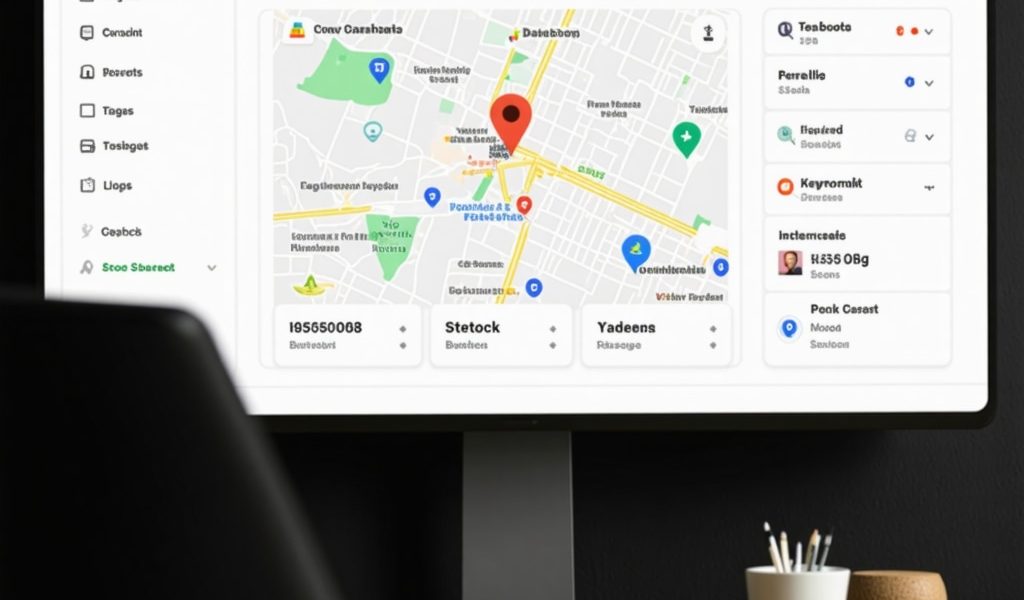Unlocking the Power of Keywords in Your Google My Business Description
In the fiercely competitive arena of local search, a well-crafted Google My Business (GMB) description can be your secret weapon. Leveraging strategically selected keywords within your GMB description not only clarifies your business identity but also significantly amplifies your local visibility. This is not mere keyword stuffing; it is an artful integration of relevant, high-impact terms that resonate with your target audience’s search intent.
Crafting Descriptions That Speak Both to Algorithms and Humans
Optimizing your GMB description demands a thoughtful balance: it must appeal to Google’s algorithmic preferences and engage potential customers authentically. This means embedding keywords that accurately describe your services and location while maintaining natural readability. For instance, a boutique coffee shop in Brooklyn might include terms like “Brooklyn artisan coffee,” “local coffee roasters,” and “handcrafted espresso drinks.” Such keywords are semantically related and improve relevance signals for Google Maps and local search results.
What Are the Best Practices for Using Keywords in GMB Descriptions Without Penalties?
Google’s guidelines emphasize authenticity and relevance. Overloading your description with repetitive keywords may trigger penalties or reduce user trust. Instead, focus on contextual keyword placement that enriches your narrative. Incorporate variations and long-tail keywords naturally—for example, “eco-friendly carpet cleaning in downtown Denver” rather than just “carpet cleaning.” This approach helps you capture niche local searches and enhances your profile’s discoverability.
Harnessing Semantic SEO to Boost Your Local Ranking
Latent Semantic Indexing (LSI) keywords play an essential role in creating a robust GMB description. These are terms related to your primary keywords that help search engines understand the context and breadth of your business. For example, a local gym might use LSI keywords like “personal training,” “fitness classes,” and “weightlifting equipment.” These enrich your description, making it more comprehensive and authoritative in Google’s eyes.
Real-World Impact: A Case Study in Local SEO Success
Consider a neighborhood dental practice that revamped its GMB description by incorporating targeted keywords such as “family dentist in Springfield,” “emergency dental care,” and “cosmetic dentistry services.” Within three months, their local search impressions increased by 45%, and they secured a coveted spot in the Google Local 3-Pack. This practical example illustrates how deliberate keyword use in GMB descriptions can translate directly into increased foot traffic and patient inquiries.
For further insights on optimizing your Google Business profile, explore our comprehensive guide on effective GMB optimization.
Encouraging Engagement Beyond Keywords
While keywords form the backbone of your GMB description, user engagement signals such as reviews, photos, and regular updates are equally vital. Engage your local audience by encouraging authentic reviews and updating your profile frequently. These practices complement your keyword strategy and strengthen your local SEO authority.
If you’ve found these insights valuable, consider sharing your thoughts or questions below—engagement helps us all grow stronger in local search expertise!
Authoritative studies from Moz and Search Engine Land further validate the critical role of keyword-rich, user-centric GMB descriptions in local search rankings, emphasizing that nuanced optimization surpasses generic keyword stuffing. Embrace this sophisticated approach to stand out in your local marketplace.
Why Consistency Across Your Profile Matters More Than You Think
When I first started optimizing Google My Business profiles, I underestimated the impact of consistency in keywords and business information across all online platforms. I remember a client whose business name was slightly different on their website, social media, and GMB listing. This discrepancy confused Google’s algorithm and led to a drop in local search rankings. It was only after aligning their business name, address, and phone number (NAP) with consistent keyword-rich descriptions everywhere that their visibility improved significantly.
Ensuring that your keywords don’t just appear in your GMB description but are also reflected in your website content and other local citations is crucial. This synergy creates a strong signal to Google that your business is credible and authoritative in your niche. If you’re curious about aligning your GMB profile effectively, check out our detailed guide on optimizing your Google Business listing.
How Can Regular Profile Updates Influence Your Local SEO?
One question I often get from business owners is: “Does updating my GMB profile regularly really affect my rankings?” From personal experience and industry insights, the answer is a resounding yes. Google favors active profiles that provide fresh and relevant information.
For example, posting weekly updates about promotions, new services, or seasonal changes keeps your profile dynamic and signals to Google that your business is engaged with its audience. I once helped a local bakery implement a weekly posting strategy, and within just two months, their customer inquiries via Google Maps increased by over 30%. This strategy works hand-in-hand with keyword integration by naturally embedding relevant terms in your posts.
According to a Moz analysis on GMB SEO best practices, regularly updating your profile is one of the top factors influencing local search rankings. This research aligns perfectly with what I’ve witnessed firsthand.
Balancing Reviews and Keywords: A Personal Reflection
Another aspect I can’t stress enough is the interplay between keywords and customer reviews. While your GMB description sets the stage, reviews add the authenticity and social proof that algorithms and customers both rely on.
Encouraging customers to mention specific services or locations in their reviews can organically boost your keyword relevance. I recall a landscaping business that started gently prompting clients to mention “organic lawn care” and their neighborhood name in reviews. Over time, these reviews helped the business rank higher for those search terms without any artificial keyword stuffing.
Want to dive deeper into harnessing customer reviews for SEO? Our post on boosting small business SEO with Google Business optimization offers practical tips you’ll find useful.
If you’ve tried any of these strategies or have questions about your own Google Business profile, I’d love to hear your experiences in the comments below. Sharing our journey helps all of us grow stronger in the local SEO landscape!
Decoding Behavioral Signals: The Next Frontier in Google My Business Optimization
Beyond keywords and content consistency, Google increasingly relies on behavioral signals to assess your business’s relevance and popularity in local searches. Elements such as click-through rates (CTR) on your GMB listing, the frequency of customer actions (calls, direction requests, website visits), and even the dwell time on your profile can impact your local ranking. These nuances highlight the importance of not only crafting an optimized description but also fostering meaningful user interactions that signal value to Google’s algorithm.
For example, a high CTR on your GMB profile indicates to Google that your listing is attractive and relevant to searchers. Similarly, if users frequently request directions or call your business after visiting your profile, it signals active engagement and trustworthiness. These behavioral metrics are subtle yet powerful factors that complement traditional SEO tactics.
How Can Businesses Effectively Track and Leverage User Behavior Metrics to Enhance Their GMB Performance?
Google My Business provides insights reports that include data on how customers find your listing and what actions they take. Regularly analyzing these metrics allows you to identify patterns and opportunities. For instance, if you notice a low CTR despite good impressions, it may be time to revise your headline or description to better match search intent.
Moreover, integrating Google Analytics with your website can help correlate traffic from GMB with user engagement on your site, enabling a comprehensive understanding of your customer journey.
To maximize behavioral signals, consider deploying tactics like:
- Incentivizing reviews that mention specific services or locations, increasing keyword diversity organically.
- Posting timely updates and offers that encourage clicks and interactions.
- Ensuring your photos are compelling and regularly refreshed to capture attention.
This multi-layered approach not only boosts your local SEO but also enhances the overall customer experience.
Harnessing Structured Data Markup to Amplify Your Local Visibility
Structured data, or schema markup, is an advanced SEO technique that helps search engines better understand your business details. By adding specific schema types like LocalBusiness or Service to your website, you provide explicit signals about your offerings, location, and reviews, which can enrich your GMB profile and search snippets.
Implementing structured data can lead to enhanced search features such as rich snippets, knowledge panels, and even voice search readiness. For local businesses, this means higher chances of appearing in featured snippets and answer boxes, which prominently position your brand in search results.
Google’s Search Central documentation (Google Developers: Local Business Structured Data) offers detailed guidance on implementing these markups effectively. While it requires technical expertise, the investment often results in significant gains in search visibility and click-through rates.
Integrating AI-Powered Tools for Dynamic GMB Optimization
The advent of AI and machine learning tools has revolutionized how businesses optimize their Google My Business profiles. These platforms analyze vast datasets to suggest optimal keywords, content updates, and posting schedules tailored to your specific market and competition.
For instance, some AI-driven tools can scan competitor GMB listings in your area, uncovering keyword gaps and content opportunities you might have overlooked. Additionally, they can automate review responses, monitor reputation, and provide sentiment analysis to help you maintain a positive online presence consistently.
By embracing these technologies, businesses gain a competitive edge, ensuring that their profiles remain agile and aligned with evolving search algorithms and user behaviors.
If you’re eager to explore how AI can elevate your GMB strategy, consider experimenting with platforms like BrightLocal or SEMrush’s local SEO tools, which offer tailored insights and automation features.
Engage with us below if you have experiences or questions about integrating AI in local SEO—we’re here to share, learn, and grow together.
Decoding Behavioral Signals: The Next Frontier in Google My Business Optimization
Beyond keywords and content consistency, Google increasingly relies on behavioral signals to assess your business’s relevance and popularity in local searches. Elements such as click-through rates (CTR) on your GMB listing, the frequency of customer actions (calls, direction requests, website visits), and even the dwell time on your profile can impact your local ranking. These nuances highlight the importance of not only crafting an optimized description but also fostering meaningful user interactions that signal value to Google’s algorithm.
For example, a high CTR on your GMB profile indicates to Google that your listing is attractive and relevant to searchers. Similarly, if users frequently request directions or call your business after visiting your profile, it signals active engagement and trustworthiness. These behavioral metrics are subtle yet powerful factors that complement traditional SEO tactics.
How Can Businesses Effectively Track and Leverage User Behavior Metrics to Enhance Their GMB Performance?
Google My Business provides insights reports that include data on how customers find your listing and what actions they take. Regularly analyzing these metrics allows you to identify patterns and opportunities. For instance, if you notice a low CTR despite good impressions, it may be time to revise your headline or description to better match search intent.
Moreover, integrating Google Analytics with your website can help correlate traffic from GMB with user engagement on your site, enabling a comprehensive understanding of your customer journey.
To maximize behavioral signals, consider deploying tactics like:
- Incentivizing reviews that mention specific services or locations, increasing keyword diversity organically.
- Posting timely updates and offers that encourage clicks and interactions.
- Ensuring your photos are compelling and regularly refreshed to capture attention.
This multi-layered approach not only boosts your local SEO but also enhances the overall customer experience.
Harnessing Structured Data Markup to Amplify Your Local Visibility
Structured data, or schema markup, is an advanced SEO technique that helps search engines better understand your business details. By adding specific schema types like LocalBusiness or Service to your website, you provide explicit signals about your offerings, location, and reviews, which can enrich your GMB profile and search snippets.
Implementing structured data can lead to enhanced search features such as rich snippets, knowledge panels, and even voice search readiness. For local businesses, this means higher chances of appearing in featured snippets and answer boxes, which prominently position your brand in search results.
Google’s Search Central documentation (Google Developers: Local Business Structured Data) offers detailed guidance on implementing these markups effectively. While it requires technical expertise, the investment often results in significant gains in search visibility and click-through rates.
Integrating AI-Powered Tools for Dynamic GMB Optimization
The advent of AI and machine learning tools has revolutionized how businesses optimize their Google My Business profiles. These platforms analyze vast datasets to suggest optimal keywords, content updates, and posting schedules tailored to your specific market and competition.
For instance, some AI-driven tools can scan competitor GMB listings in your area, uncovering keyword gaps and content opportunities you might have overlooked. Additionally, they can automate review responses, monitor reputation, and provide sentiment analysis to help you maintain a positive online presence consistently.
By embracing these technologies, businesses gain a competitive edge, ensuring that their profiles remain agile and aligned with evolving search algorithms and user behaviors.
If you’re eager to explore how AI can elevate your GMB strategy, consider experimenting with platforms like BrightLocal or SEMrush’s local SEO tools, which offer tailored insights and automation features.
Engage with us below if you have experiences or questions about integrating AI in local SEO—we’re here to share, learn, and grow together.
Frequently Asked Questions (FAQ)
What is the ideal length for a Google My Business description?
Google allows up to 750 characters for the GMB description, but the optimal length typically ranges between 250 to 500 characters. This range ensures concise, keyword-rich content that effectively communicates your business offerings without overwhelming readers or risking keyword stuffing penalties.
How can I avoid keyword stuffing while optimizing my GMB description?
Focus on natural integration of relevant keywords and their semantic variations within meaningful sentences. Use long-tail keywords and contextually related terms instead of repeating the same phrase. Prioritize clarity and user engagement to maintain authenticity, which Google rewards.
Can updating my GMB profile regularly really improve my local SEO ranking?
Yes. Regular updates signal to Google that your business is active and engaged. Posting fresh content such as promotions, new services, or events not only keeps your audience informed but also boosts your profile’s relevance and visibility in local search results.
How do customer reviews impact keyword relevance on my GMB listing?
Reviews that naturally mention specific services, products, or locations enhance your listing’s keyword diversity and relevance. Encouraging customers to include such terms organically builds social proof and improves your local search rankings without artificial keyword insertion.
What role do behavioral signals play in Google My Business optimization?
Behavioral signals like click-through rates, calls, direction requests, and profile dwell time indicate user engagement and listing relevance to Google. High engagement metrics can improve local search rankings by demonstrating that your business meets searchers’ needs effectively.
How can I track and leverage user behavior data from my GMB profile?
Use the Google My Business Insights dashboard to monitor how customers find your listing and their interactions. Combine this data with Google Analytics on your website to gain deeper insights into customer journeys, enabling you to refine your profile and marketing strategies.
What is structured data markup and how does it benefit my local SEO?
Structured data markup (schema) is code added to your website that helps search engines understand your business details like type, location, services, and reviews. Implementing it can lead to rich search features such as knowledge panels and enhanced snippets, increasing visibility and click-through rates.
Are AI-powered tools effective for optimizing Google My Business profiles?
Absolutely. AI tools analyze competitors, recommend keywords, automate review responses, and monitor reputation, providing actionable insights and saving time. They help keep your profile aligned with evolving algorithms and user behavior trends for sustained local SEO success.
How important is consistency of business information across online platforms?
Consistency of your Name, Address, Phone number (NAP), and keyword usage across your website, GMB, and other local citations is crucial. It signals trustworthiness and authority to Google, preventing ranking drops caused by conflicting information.
Can photos and visual content influence my Google My Business performance?
Yes. High-quality, regularly updated photos attract more clicks and engagement, improving behavioral signals like dwell time and CTR. Visual content complements your keyword strategy by enhancing user experience and reinforcing your brand’s local presence.
Trusted External Sources
- Moz Local SEO Guide: Provides in-depth analysis and best practices on optimizing GMB listings and local SEO strategies, including keyword use and behavioral signals.
- Google Search Central – Local Business Structured Data: Official documentation detailing schema markup implementation for local businesses to enhance search appearance.
- BrightLocal Local SEO Tools: Industry-leading platform offering AI-driven insights, competitor analysis, and reputation management specifically for local business optimization.
- Search Engine Land – Local SEO Section: Offers expert articles and case studies on evolving local SEO tactics, including GMB optimization and user engagement factors.
- Google My Business Help Center: Authoritative resource for guidelines, updates, and technical support on managing and optimizing GMB profiles effectively.
Conclusion
Mastering the art of Google My Business description optimization is a pivotal step toward elevating your local search presence. By thoughtfully integrating strategically chosen keywords and their semantic variants, maintaining consistency across platforms, and fostering genuine user engagement through reviews and fresh content, your GMB profile transforms into a powerful local SEO asset. Additionally, leveraging behavioral signals, structured data markup, and AI-powered tools amplifies your competitive edge in an increasingly dynamic search landscape.
Remember, successful local SEO is not about shortcuts or keyword stuffing but about creating authentic, relevant, and user-centered content that resonates with both Google’s algorithm and your community. Apply these expert strategies to unlock your business’s full potential in local search rankings.
If you found this comprehensive guide insightful, please share it with fellow business owners, leave your comments or questions below, and explore our related expert articles to continue advancing your local SEO journey.




I found the emphasis on balancing keyword integration with natural readability particularly insightful. It’s tempting to just load your GMB description with all possible keywords, but as the article highlights, Google values authenticity and user engagement over keyword stuffing. I’ve managed a local boutique shop’s online presence and applying contextual and long-tail keywords like “handcrafted artisan jewelry in Charleston” made a noticeable difference in the quality of local leads. The case study about the dental practice resonated with me—real impact comes from targeted, deliberate optimization rather than guessing. Also, the point about maintaining consistency across all platforms can’t be overstated. I once saw a client lose ranking because their NAP details were inconsistent between their website and GMB listing. I’m curious, for those who’ve optimized GMB profiles, how do you balance adding fresh updates regularly without it becoming overwhelming or too promotional? Has anyone found a posting schedule or content mix that keeps the profile engaging but authentic?
I really appreciate the emphasis on using long-tail and semantic keywords naturally within the GMB descriptions. From my experience managing local restaurant listings, I’ve noticed that including specific service-related keywords like “vegan gluten-free cafe in downtown Portland” not only helps attract targeted traffic but also aligns well with Google’s evolving SEO priorities. The part about maintaining consistency across all online platforms really hit home—I’ve seen businesses lose valuable rankings due to mismatched NAP details or inconsistent keyword usage, which can confuse both Google and potential customers.
Regarding regular updates, I found that scheduling weekly or bi-weekly posts about new menu items or events helps keep the profile active without feeling overwhelming. How do others here balance promotional content with authentic engagement? Do you have specific strategies or tools that help streamline this process while maintaining authenticity? Would love to hear different approaches.
This comprehensive article emphasizes the delicate balance between keyword optimization and authentic user engagement in GMB descriptions. From my experience working with small local businesses, I can attest that adding long-tail keywords naturally not only improves visibility but also enhances credibility. For instance, a local bakery I consult with started including phrases like “gluten-free sourdough in Austin” and saw a noticeable uptick in targeted inquiries.
I particularly resonated with the point about consistency across online profiles. Inconsistent NAP details or keyword usage can really dilute your local SEO efforts. Over the years, I’ve found that creating a content calendar for regular updates—such as promotions, new menu items, or community involvement—helps keep the profile fresh without feeling overwhelming.
How do others here plan and execute their profile updates? Do you prefer weekly posts, or do you find a bi-weekly or monthly schedule works better for maintaining quality and engagement? Sharing your strategies could inspire more balanced approaches for those starting out.